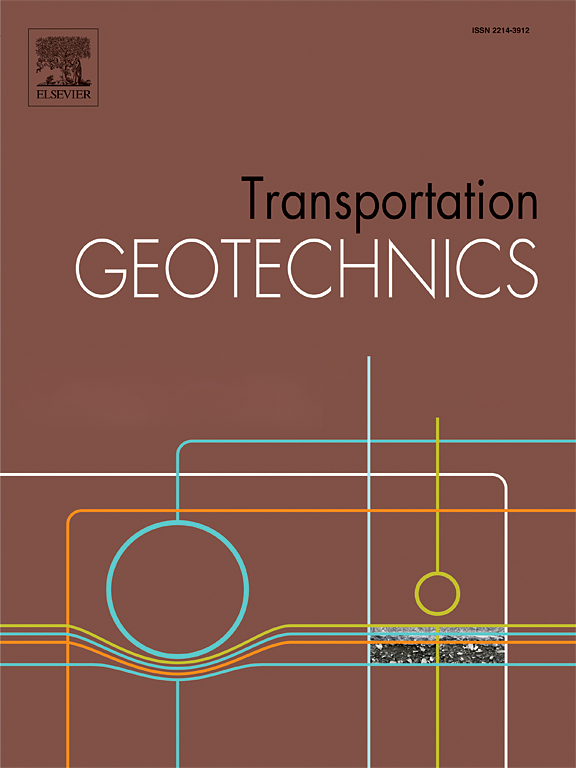Performance evaluation of geogrid-stabilized steel slag layer of pavement under repeated cyclic loading
IF 4.9
2区 工程技术
Q1 ENGINEERING, CIVIL
引用次数: 0
Abstract
In this study, combinations of Electric Arc Furnace (EAF) slag, geogrid, and subgrade material were subjected to laboratory tests, and their deformation and strength responses under cyclic loading were evaluated. EAF slag with an average particle size (D50) of 7 mm was tested in combination with conventional subgrade material in cyclic triaxial and large-scale tests. The primary objective of this study is to ascertain the viability of EAF slag as a base or subbase material and to explore the role of a multi-axial, multi-aperture shape geogrid in stabilizing the EAF slag layer and subgrade within the pavement system. The experimental findings demonstrate that EAF slag can be effectively utilized in the subbase layer due to its high strength and interlocking properties. The mechanical performance of the slag exhibits competitive outcomes in comparison to conventional materials in terms of resilient modulus and deformation resistance. When geogrid was incorporated into the base course, substantial reductions in permanent deformation and strain accumulation were observed. For instance, after 100,000 loading cycles, the deformation beneath the loading plate was measured at 12 mm in the slag–geogrid–subgrade system and 35 mm in the slag–subgrade system, indicating a 65 % reduction. Moreover, the lateral deformation around the loading plate was reduced by 58 %, and cumulative strain was reduced by 78 %. The resilient modulus tests (i.e., repeated load triaxial testing) revealed that the EAF slag provides sufficient stiffness to be used in road foundation applications. At high bulk stress levels (e.g., σ3 = 137.9 kPa), the resilient modulus of the slag-containing systems was found to be comparable to conventional materials. Geogrid increased this value by 10–25 %, contributing to enhanced bearing capacity. These findings indicate that EAF slag has strong potential as a sustainable alternative to conventional materials and can be utilized effectively in the base course layer. Furthermore, when stabilized with a multi-axial, multi-aperture shape geogrid, the deformation of the pavement is significantly reduced, and the overall stiffness of the pavement foundation is improved.
重复循环荷载作用下土工格栅稳定路面钢渣层的性能评价
在这项研究中,电弧炉(EAF)渣、土工格栅和路基材料的组合进行了实验室试验,并评估了它们在循环荷载下的变形和强度响应。将平均粒径D50为7 mm的电弧炉炉渣与常规路基材料进行了循环三轴试验和大型试验。本研究的主要目的是确定电弧炉炉渣作为基层或次基层材料的可行性,并探讨多轴、多孔径形状土工格栅在稳定路面系统内电弧炉炉渣层和路基中的作用。试验结果表明,电炉炉渣具有较高的强度和联锁特性,可以有效地利用在亚基层中。与传统材料相比,矿渣的力学性能在弹性模量和抗变形能力方面具有竞争力。当土工格栅纳入基层时,观察到永久变形和应变积累的显著减少。例如,在10万次加载循环后,加载板下的变形在渣-土工格栅-路基系统中测量为12 mm,在渣-路基系统中测量为35 mm,表明减少了65%。此外,加载板周围的侧向变形减少了58%,累积应变减少了78%。弹性模量试验(即重复加载三轴试验)表明,电弧炉炉渣具有足够的刚度,可用于道路基础应用。在高体积应力水平下(例如σ3 = 137.9 kPa),含渣体系的弹性模量与传统材料相当。土工格栅将这一数值提高了10 - 25%,有助于增强承载能力。研究结果表明,电炉渣作为一种可持续的替代材料具有很强的潜力,可以有效地利用在基层。此外,采用多轴、多孔径形状土工格栅稳定后,路面变形明显减小,路面基础整体刚度得到提高。
本文章由计算机程序翻译,如有差异,请以英文原文为准。
求助全文
约1分钟内获得全文
求助全文
来源期刊

Transportation Geotechnics
Social Sciences-Transportation
CiteScore
8.10
自引率
11.30%
发文量
194
审稿时长
51 days
期刊介绍:
Transportation Geotechnics is a journal dedicated to publishing high-quality, theoretical, and applied papers that cover all facets of geotechnics for transportation infrastructure such as roads, highways, railways, underground railways, airfields, and waterways. The journal places a special emphasis on case studies that present original work relevant to the sustainable construction of transportation infrastructure. The scope of topics it addresses includes the geotechnical properties of geomaterials for sustainable and rational design and construction, the behavior of compacted and stabilized geomaterials, the use of geosynthetics and reinforcement in constructed layers and interlayers, ground improvement and slope stability for transportation infrastructures, compaction technology and management, maintenance technology, the impact of climate, embankments for highways and high-speed trains, transition zones, dredging, underwater geotechnics for infrastructure purposes, and the modeling of multi-layered structures and supporting ground under dynamic and repeated loads.
 求助内容:
求助内容: 应助结果提醒方式:
应助结果提醒方式:


